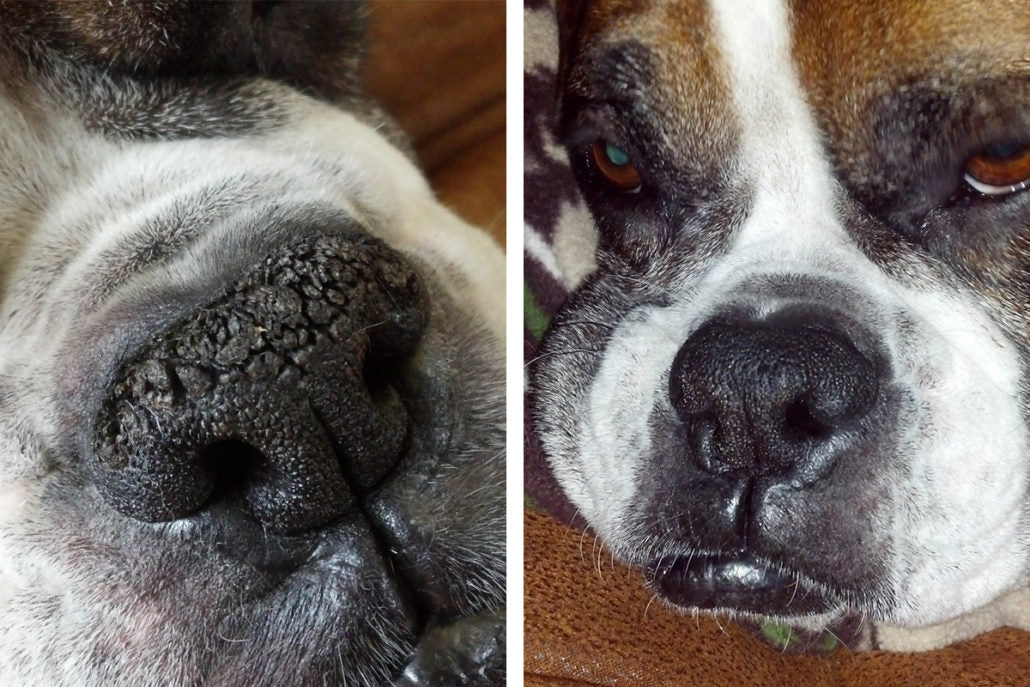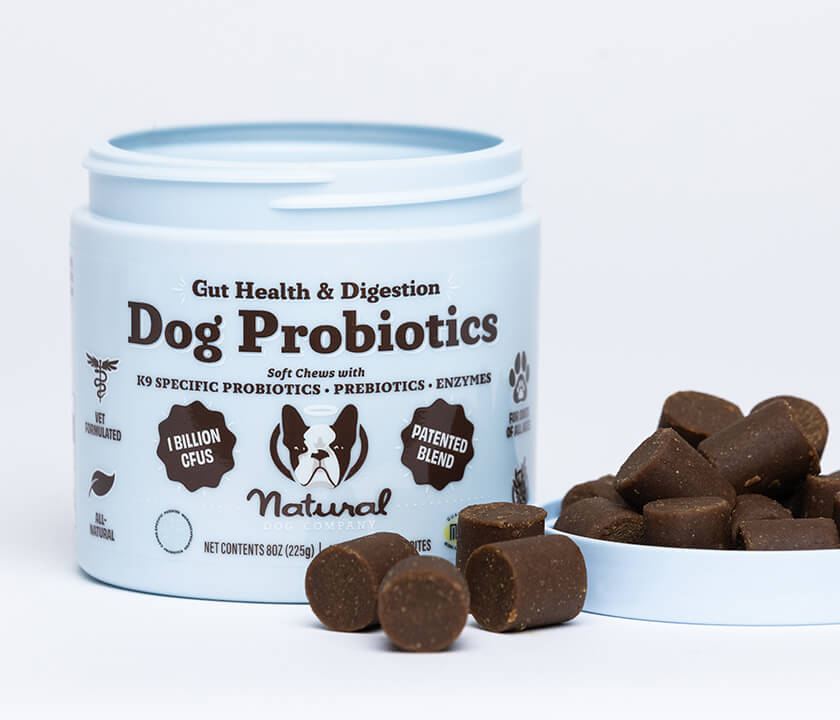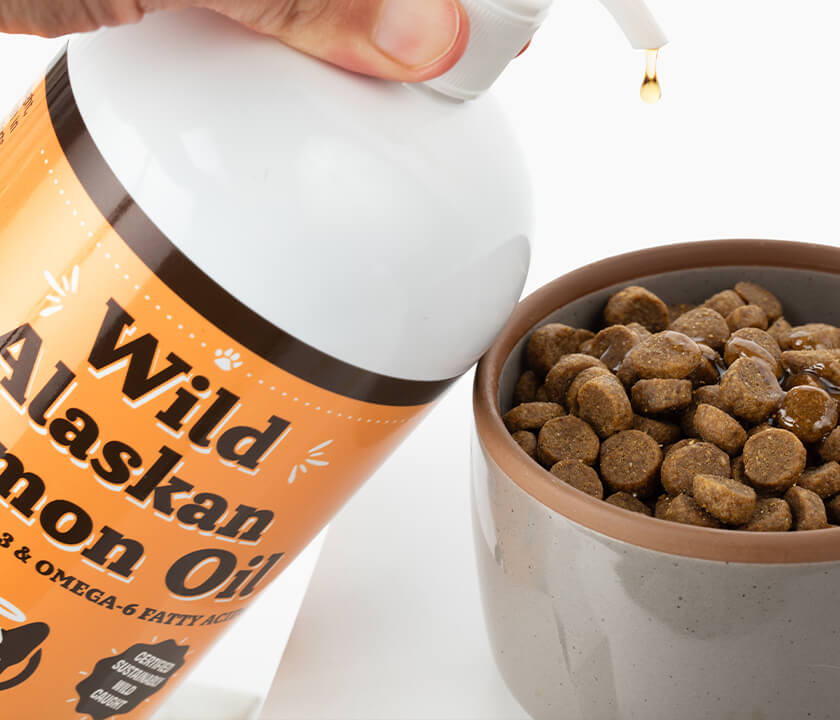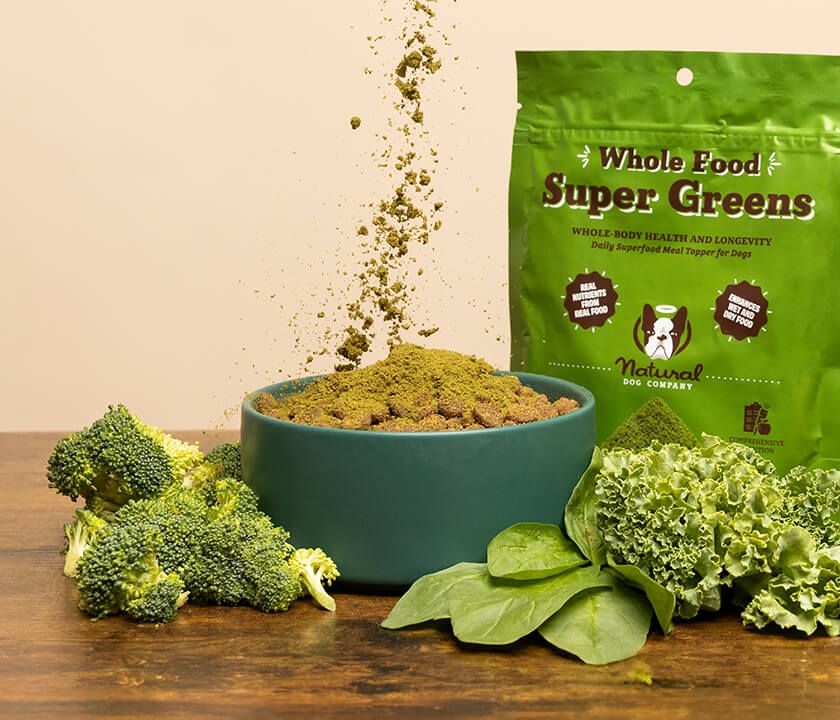To naturally treat canine hyperkeratosis, you need an understanding of this skin condition and what causes it. Hyperkeratosis may sound scary, but it’s simply a condition that causes your dog’s nose or paws to thicken and become excessively hard.
When your dog’s body produces excess keratin—the fibrous proteins that make up the outer layer of skin—it causes excessive skin growth. As a result, you’ll see a build-up of hard, thick, dry, and calloused skin. If left untreated, this brittle skin can crack, bleed, and even become infected.
Dog Nasal Hyperkeratosis versus Dog Foot Pad Hyperkeratosis
Hyperkeratosis is broken down into its two most common types: nasal hyperkeratosis and foot pad hyperkeratosis (also called “hairy dog feet”).

Nasal Hyperkeratosis on an American Bulldog’s nose
Nasal hyperkeratosis impacts your dog’s nose and muzzle area, while foot pad hyperkeratosis impacts your dog’s feet.
Both types of hyperkeratosis can be incredibly uncomfortable and even painful for your dog. Nasal hyperkeratosis diminishes a dog’s incredible sniffing abilities, their most valuable sense. Dogs can smell with far greater capacity than humans, which is why they rely on their sense of smell to investigate the world and stay safe. Since optimal sniffing requires a moist, smooth nose pad, a dog with nasal hyperkeratosis cannot smell properly.

Foot pad hyperkeratosis on a dog’s paw
Foot pad hyperkeratosis affects a dog’s paw pads and can cause mobility issues, leading to limping or an altered gait as the dog tries to tread lightly and avoid pressing on the hyperkeratosis spikes. Additionally, if a dog spends a lot of time outdoors in dirt and on other unclean surfaces, their dry and cracked paws could easily become infected.
What Causes Dog Hyperkeratosis?
Most dogs could develop hyperkeratosis at any point. Certain dog breeds have a genetic predisposition to developing it more often, including Golden Retrievers, Irish and Bedlington Terriers, Labradors, and Dogues de Bordeaux. In most cases, if your dog’s genes caused the formation of hyperkeratosis, you’ll notice it within the first year of his or her life.
Idiopathic hyperkeratosis develops for unknown reasons and more commonly affects older dogs.
Dog Hyperkeratosis can also occur as a symptom of one of the following underlying issues:
- Canine Distemper: A rare virus that can be avoided with proper puppy immunizations. Dogs with distemper develop a variety of symptoms, including nasal hyperkeratosis.
- Leishmaniasis: A parasite-induced illness often related to sandflies that can cause hyperkeratosis. There are medications available to treat this illness.
- Pemphigus Foliaceus: This is one of the most common autoimmune skin diseases in both cats and dogs. It causes hyperkeratosis to form on paw pads and is diagnosed with a biopsy.
- Zinc Responsive Dermatosis: If your dog does not properly absorb zinc, they may develop zinc responsive dermatosis, and as a result, hyperkeratosis. Zinc supplements are often prescribed as treatment.
How to Naturally Treat Dog Hyperkeratosis
While there is no exact treatment regimen for hyperkeratosis, there are two highly effective, natural products proven to soothe, heal and prevent the formation of hyperkeratosis spikes.
How to Treat Dog Nose Hyperkeratosis
Snout Soother is specially formulated to effectively treat dog hyperkeratosis of the snout. No matter how dry, cracked, bloody or damaged your dog’s nose may be, Snout Soother is your dog’s superhero.
The moment you apply the dog-approved balm to your pup’s nose, they should feel a sense of relief. Sort of like when you have really dry lips and you apply Chapstick, it just feels so much better. Regular use of Snout Soother can help prevent reformation of nasal hyperkeratosis, too.
How to Treat Dog Paw Pad Hyperkeratosis

Paw Soother keeps pads soft, smooth, and healthy. @honeyb_doodle
Paw Soother is specially formulated to effectively treat hyperkeratosis of the paw pads. The 100% all-natural balm soothes and heals thanks to a perfect blend of herbal-based plant oils and butters. Every ingredient plays an important role: organic coconut oil provides intense moisturizing as well as anti-inflammatory properties, while Vitamin E grants the skin a much-needed boost of collagen production and cell regeneration.
Why Natural Treatments are so Important for Your Dog
Dogs that develop hyperkeratosis tend to be more sensitive, which is why it’s vital to use the most gentle, all-natural, and carefully sourced ingredients. Our products are so safe that even if your dog ingests the entire tube, you have nothing to worry about.
Effective Natural Solutions for Canine Hyperkeratosis

Our Boxer, Teddy, had such a dry, cracked, bulbous nose that I didn’t know what was wrong with him. One day, I noticed a small piece of his nose had actually fallen off. We took him to the vet, and they thought he probably had hyperkeratosis, and they said to try aloe lotion on his nose. I bought some right away, and after I applied it, Teddy started to sneeze.
I decided to do some online research, and came upon your website for Snout Soother. I like that it has natural ingredients, unlike the lotions in the local stores. I saw the before and after pictures, and thought if it really worked that well for those dogs, surely it could help Teddy. As soon as I received it in the mail, I started using it liberally twice a day. Teddy would try to lick some of it off his nose, but with the natural ingredients, I wasn’t worried that it would hurt him.
Snout Soother helped moisturize Teddy’s nose, and the cracked, raised pieces on his nose started gradually crumbling off, revealing a nice, smooth, black nose. After a week or two, his nose was normal again! I am going to keep using Snout Soother again every day, to maintain his beautiful nose so it doesn’t return to the condition that it was before discovering your product. We told our vet about Snout Soother because we are so pleased with the results. Thank you for coming up with such a wonderful product! — Chad and Trisha Carr

My Lab has hyperkeratosis, I have tried several products for months and so many are just made to protect, but my Koda needs moisture and healing too. We have been using Natural Dog Company Paw Soother for about a month and I have seen a huge difference his paws are so much better. I would definitely recommend.” — Julie Owen












